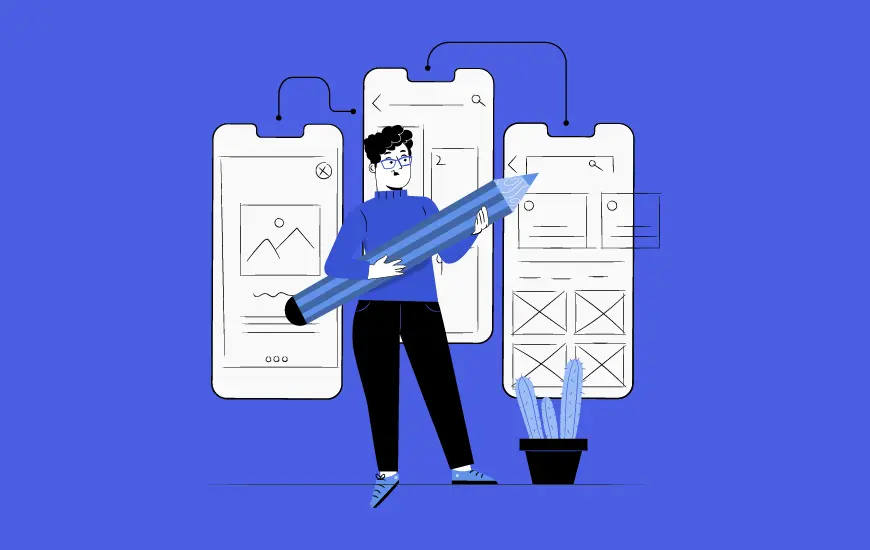- A Statistical Overview of Why Businesses Are Now Exploring AI-Driven User Experience
- The Guiding Principles that Combine Mobile App Design with AI and ML
- Develop Shared Language
- Focus on Use Case
- Mix Quantitative and Qualitative Data
- Bring Your Combined Data to Real-Life Setting
- Be Transparent About Collecting Data
- Tools That Use Artificial Intelligence for Design
- Canva
- Autodesk Generative Design
- Prisma and Deepart
- Tailor Brands
- Adobe Sensei
- Unlocking the Power of Artificial Intelligence: Real-World AI Use Cases in UX
- Dominos
- Amazon
- Netflix
- Spotify
- Revolutionizing AI in User Experience Design: 6 Key Benefits to Embrace
- 1. Personalization
- 2. Enhanced User Support
- 3. Improved User Interfaces
- 4. Predictive Analytics
- 5. Streamlined Workflows
- 6. Continuous Improvement
- Initiate Your AI-Driven User Experience Journey With Appinventiv
- FAQs
Crafting a seamless and captivating mobile app user experience is crucial in today’s rapidly evolving digital landscape. The rise of Artificial Intelligence (AI) has provided designers with an incredible opportunity to transform their approach.
By leveraging AI in user experience, designers can gain invaluable insights, foster innovation, and revolutionize user engagement in mobile apps. Artificial intelligence, like several other technologies, has also found a place in the mobile app design vertical, giving birth to the concept of artificial intelligence user interface design. A concept that ought to bring a new level to the relationship between UX and AI.
AI enables intuitive interfaces and personalized recommendations, offering endless possibilities to enhance user satisfaction and drive app success. Imagining artificial intelligence in situations and use cases where massive data is in the picture makes perfect sense. But what happens when the situation is entirely based on human discretion? Will the use of AI in UX design also be able to do what AI did to several other industry verticals?
In this blog, we will learn about the guiding principles of mobile app design when combined with the power of AI and ML, AI-based UX design tools, key benefits of embracing AI for UX design, and its use cases. Let’s begin by learning how AI is used by businesses for various purposes in the graph below.
A Statistical Overview of Why Businesses Are Now Exploring AI-Driven User Experience
In a recent Statista survey, a staggering 60% of respondents revealed that the primary motivation behind improving UX through AI is to predict customer behavior and anticipate their needs accurately. Additionally, an impressive 47% of these leaders reported that they utilized AI for UX design to uncover the frequently traversed customer journeys within their marketing companies.
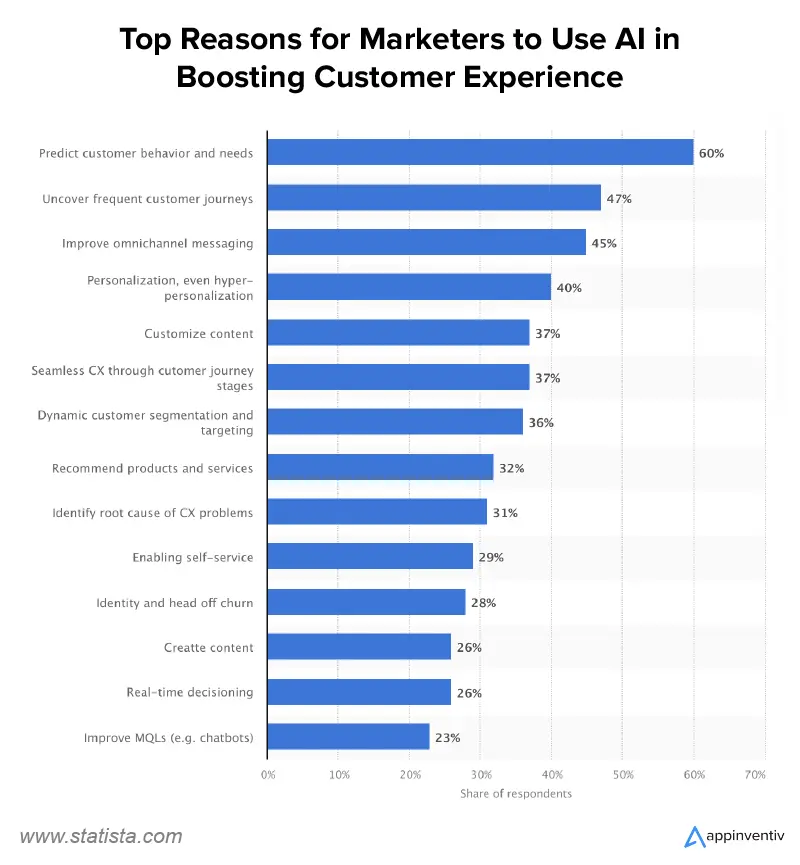
These findings highlight the widespread recognition of AI’s potential to revolutionize customer experience and provide valuable insights for businesses seeking to leverage AI in their marketing strategies.
The Guiding Principles that Combine Mobile App Design with AI and ML
Mobile app design and AI/ML can work together seamlessly to create user-friendly and intelligent applications. Designers can enhance user experiences and deliver personalized content by incorporating AI and machine learning algorithms into the design process. Embracing some of the top guiding principles can help businesses stay ahead in the competitive market.
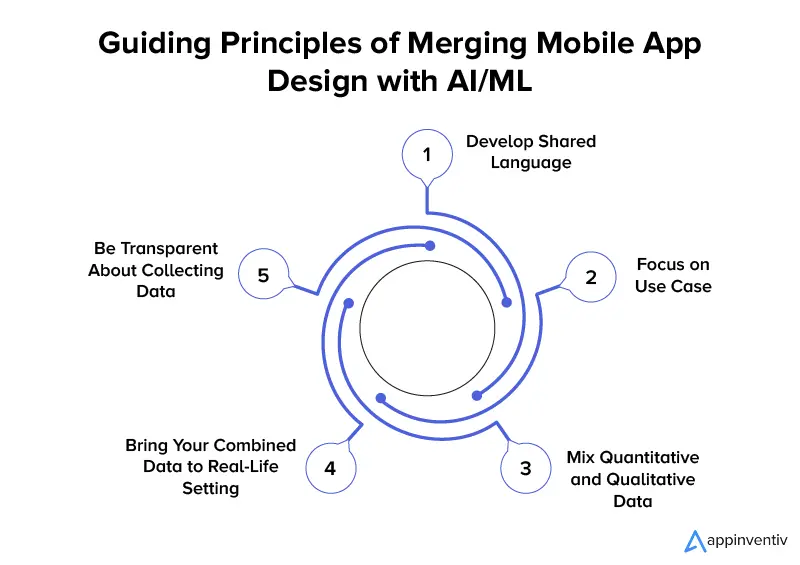
Develop Shared Language
Elements like user experience review, product vision, and business goals must be understood and shared by the team. You can create a meaningful and truly intelligent user experience if the mobile app design and machine learning development methods complement each other through shared concepts and a common language.
The machine learning experts and user experience designers should come together to develop a common blueprint that includes data pipelines and user interfaces, to set a blueprint that grounds the team’s product planning with the users’ reality.
Focus on Use Case
The important thing when developing a consumer-facing app, as the top software designers would tell you, is not the technology that backs it but the business goal and the user experience you plan to achieve. And so, it is extremely important that you crystallize the use case.
With a separate focus on the use case, you can then focus on the user flow, allowing the team to identify the main points where machine learning can be added to enhance the experience. A clear understanding of the use case also enables the mobile app design company teams to determine the right KPI for developing the user experience program, which in turn, is aligned with machine learning metrics.
Mix Quantitative and Qualitative Data
To truly grasp the impact of merging AI/ML and user experience design, it is crucial to analyze both qualitative and quantitative data. By utilizing qualitative research methods such as questionnaires and interviews, we can effectively measure how users are experiencing our app.
The reason behind our emphasis on combining these two data types is that when developing a new app, unexpected factors may arise that can influence both AI/ML and user experience. Factors like the effectiveness of the feedback loop, the ability to capture data points accurately, and user behavior are integral components of designing an artificial intelligence app. These factors can only be comprehensively addressed by thoroughly considering both qualitative and quantitative data.
Bring Your Combined Data to Real-Life Setting
You can ensure a seamless and user-friendly interface by setting up an end-to-end solution that incorporates both machine learning and user experience. An MVP that includes a working data pipeline and machine learning models allows for easy iteration and direct user feedback through beta or user testing.
When UX designers and machine learning experts collaborate and understand product design issues, the iteration process becomes productive and efficient. This partnership also enables UX designers to explore the potential of machine learning in enhancing the user experience.
Be Transparent About Collecting Data
Designing for AI requires constant effort and a special focus on the data collected. To ensure the AI is on point, it is crucial to consider the end user’s perspective during the data collection cycle. The best context can be achieved by converting data into information and iterating the design.
In addition to giving users the option to change what data is collected by the AI, you should also give them the option to change what the AI learns – to ensure that the predictions are what the users desire.
While these principles that we just saw help in giving some clarity into how the combined AI and UX design should function, let us look at how some of the famous designing and editing tools that are backed by the developer’s community across the globe are using the technology to offer better mobile app user experience.
Tools That Use Artificial Intelligence for Design
As the design industry continues to evolve, embracing AI-powered tools will be crucial for staying ahead of the competition and delivering exceptional results. Here are some of the top AI-powered UX design tools every designer should explore.
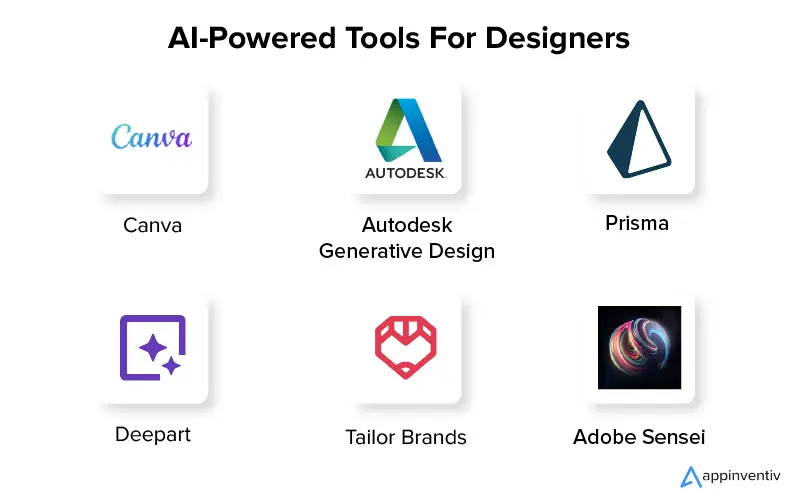
Canva
Canva is a well-known platform for graphic creation that uses AI to streamline the design process. It provides a vast library of templates, typefaces, images, and AI-powered tools that support operations like image background removal, intelligent cropping, and design recommendations.
Autodesk Generative Design
Based on a set of requirements and restrictions, Autodesk Generative Design is a software product that uses AI algorithms to produce efficient design solutions. It is employed in fields including engineering, manufacturing, and architecture to produce lighter, stronger, and more effective designs.
Prisma and Deepart
Both Prisma and Deepart image editing tools use artificial intelligence to identify the different aspects of your video and photo and transform them into your chosen style. They allow you to work around filters and colors, among other things.
Tailor Brands
The Tailor Brands logo maker is a famous product businesses use to get professional logos on a small budget. The AI designs are built upon your input, coming in the form of information that would be entered into the logo.
Adobe Sensei
Adobe Sensei is the artificial intelligence (AI) system that is built into Adobe’s suite of design applications, including Photoshop, Illustrator, and InDesign. Sensei offers functions including font recognition, intelligent upscaling, content-aware fill, and automated image labeling.
Now that you have learned about these tools let’s check out the real-world applications of AI in UX design.
Unlocking the Power of Artificial Intelligence: Real-World AI Use Cases in UX
By embracing AI in user interface and user experience, companies can stay ahead of the competition, deliver exceptional user experiences, and drive business growth. Let’s have a look at some of the top use cases.
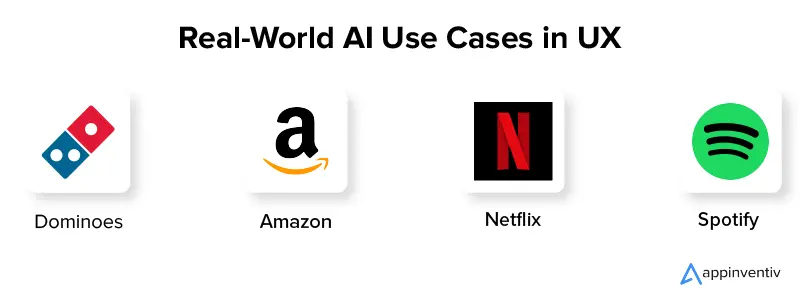
Dominos
With transformative UI/UX elements, our experts at Appinventiv helped Dominos help increase its conversion rates by 23%. The users who were once leaving the app without placing any order were now spending time within the app, navigating its intuitive features.
We also incorporated several engaging features into the Domino’s Pizza app, including the ability to filter menus by category, place online food orders, customize orders, find the closest location that offers home delivery, make in-app payments, and follow Domino’s delivery person in real-time.
Amazon
Amazon applies AI in UX functions, including customized product recommendations based on customers’ browsing and purchasing patterns. Examples of AI-driven personalization include the “recommended for you” feature and the “customers who bought this also bought” section.
Netflix
By offering specialized movie and TV program suggestions, Netflix uses AI to improve the user experience. An interactive and personalized viewing experience is produced by the platform’s analysis of user viewing patterns, ratings, and interactions.
Spotify
Spotify uses AI in UX algorithms to create customized music suggestions for its listeners. A personalized music discovery experience is offered by the “Discover Weekly” and “Release Radar” playlists, which are created using individual listening patterns, genre preferences, and collaborative filtering.
There are multiple use cases of numerous brands implementing AI in UX design to boost customer satisfaction. Let’s check out the key benefits that AI in UX offers.
Revolutionizing AI in User Experience Design: 6 Key Benefits to Embrace
Embracing the merger of UX and AI can bring transformative benefits to your business. Here are some of the benefits of AI in UX you need to know.
1. Personalization
By analyzing enormous volumes of data, such as user behavior, preferences, and previous interactions, AI approaches provide individualized user experiences. AI algorithms can use this data to create customized content, suggestions, and user interfaces that cater to the preferences and needs of each individual user.
2. Enhanced User Support
Within mobile apps, AI-powered chatbots, and virtual assistants provide consumers with immediate support. They can respond to inquiries, give advice, and make tailored suggestions based on customer preferences and previous information. Users can effortlessly browse the app, access information, and quickly resolve issues with the help of an AI-driven assistant, increasing user satisfaction and lowering support expenses.
3. Improved User Interfaces
Embracing the potential of AI in user experience can completely change how people engage with mobile apps by providing more intuitive and natural interfaces. Voice-based interactions are made possible by Natural Language Processing (NLP) tools, which let users give orders, queries, or discussions to virtual assistants. Additionally, touchless interactions made possible by AI-powered gesture detection improve user convenience and accessibility.
At Appinventiv, we created an AI-based healthcare app called YouCOMM which is a patient messaging system designed to facilitate communication between patients and hospital staff. This system allows patients to notify the staff about their needs through various modes, including head gestures, voice commands, and manual selections. YouCOMM is being implemented in over 5 hospital chains across the US, indicating its widespread adoption and recognition within the healthcare industry.
4. Predictive Analytics
Analytics that forecast user demands and behaviors are possible thanks to predictive AI algorithms that analyze user data to find patterns. Apps can provide proactive suggestions and individualized recommendations by comprehending user preferences and predicting their activities. By saving time and effort, delivering pertinent content, and boosting user engagement, predictive analytics improves the user experience.
5. Streamlined Workflows
AI can automate boring, repetitive procedures in mobile apps, saving users’ time and increasing productivity. Apps can perform background operations like data synchronization, content updates, or notifications by utilizing AI-powered automation. Users’ engagement will ultimately increase due to the workflows’ streamlining, which enables users to concentrate on their main objectives and interactions within the app.
6. Continuous Improvement
By gathering and evaluating user feedback and usage data, AI enables incremental improvements to the user experience. App developers can use AI algorithms to extract useful information from user interactions, pinpoint user pain areas, and make data-driven design decisions to improve the UX. Apps can continuously adapt and develop to better fulfill user demands by learning from user preferences and behavior.
Initiate Your AI-Driven User Experience Journey With Appinventiv
While the answer to whether machines would replace designers is next to impossible, there are ways that the designer community has started implementing AI in UI UX journey to design intuitive mobile apps in multiple ways, like –
- Getting time-taking manual works like image resizing automated.
- Making designs localized by taking the help of AI-based translation.
- Bring system consistency between users and products.
- Give insights into which elements users are interacting with that need attention.
This collaboration between designers and AI is shaping the industry’s present and forging a stronger link between AI and the future of design. Embracing the AI-driven mobile app design process is crucial for staying ahead in this cut-throat competitive marketplace.
When it comes to kickstarting your AI-driven user experience journey, Appinventiv is the ideal choice. We have worked with top global brands like KFC, Pizza Hut, Adidas, ABP Live and others by improving their user experience journey by enhancing mobile app UX with AI.
With our deep expertise in AI development services and dedication to crafting flawless user experiences makes us your trusted partner.
Count on Appinventiv to lead you through the game-changing potential of AI and elevate your digital solutions. Connect with our experts today!
FAQs
Q. How is AI used to help user experience?
A. Here are some of the ways in which artificial intelligence in user experience boosts customer satisfaction and engagement:
- Customized recommendations: Personalized suggestions are made possible by AI algorithms that examine user behavior, preferences, and historical data. This increases user engagement.
- Intelligent chatbots: AI-driven chatbots provide real-time support by responding to user questions, fixing problems, and improving the user experience.
- Predictive analytics: AI systems examine enormous volumes of user data to predict user behavior, allowing designers to proactively improve the app’s user interface, features, and content.
- NLP: AI’s ability to recognize and interpret user input through natural language processing enables apps to easily carry out voice commands, voice searches, and other language-based interactions.
- Speech and Image Recognition: AI systems can accurately analyze images and transcribe audio, enabling simple and intuitive user interactions.
Q. What AI techniques can be used to personalize the mobile app user experience?
A. AI-powered UX design techniques like machine learning, natural language processing, and recommendation systems to personalize your mobile app user experience. AI in user experience helps in delivering tailored content, personalized recommendations, and customized interfaces by analyzing user data, preferences, and behavior. This enhances user engagement and satisfaction and creates a unique and unforgettable app experience.
Q. What are the top UI patterns that give your mobile app a human-touch experience?
A. When integrating AI into your app, it’s crucial to prioritize user experience by designing UI patterns that enhance usability and make AI features more user-friendly. Here are some UI patterns that can help you achieve this goal:
- Clear and transparent feedback
- Explain AI actions
- Personalization and customization
- Contextual help and onboarding
- Error handling and recovery
- Incremental disclosure
- User control
- Ethical considerations


Excellence Together
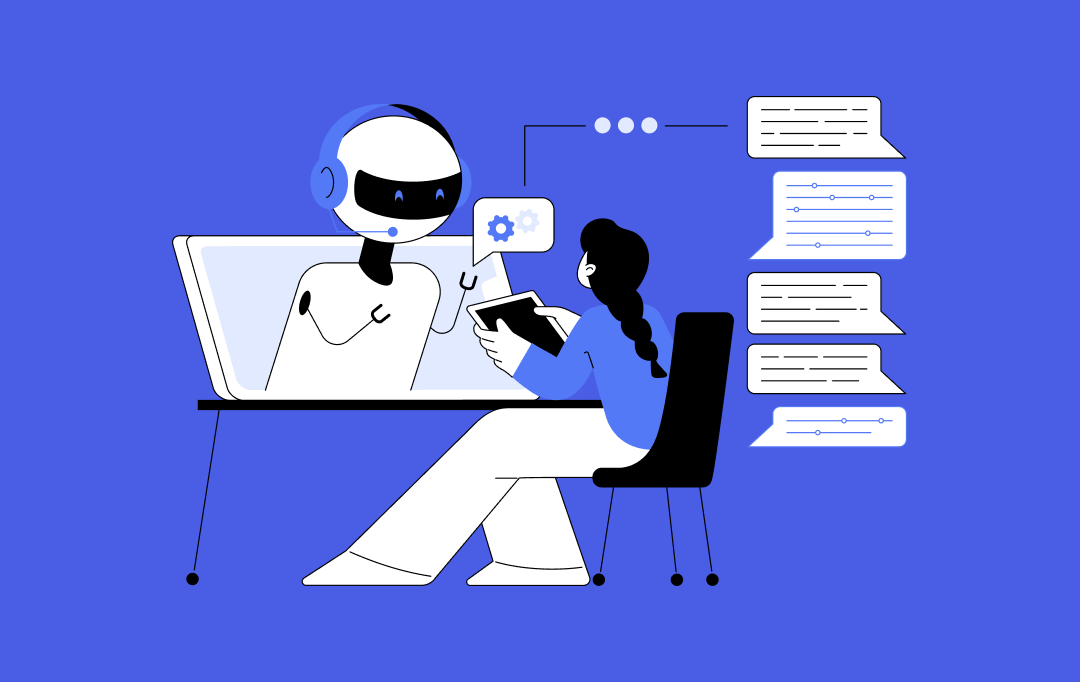
AI Recruiting - How Artificial Intelligence is Revolutionizing Talent Sourcing and Hiring
Artificial Intelligence is fundamentally transforming the recruitment landscape, streamlining processes that traditionally consume significant time and resources. With over 60% of recruiting professionals expressing optimism about AI’s impact on recruitment, the technology's impact on talent acquisition is truly commendable. AI enhances recruitment efficiency by automating routine tasks such as resume screening and initial candidate interactions,…
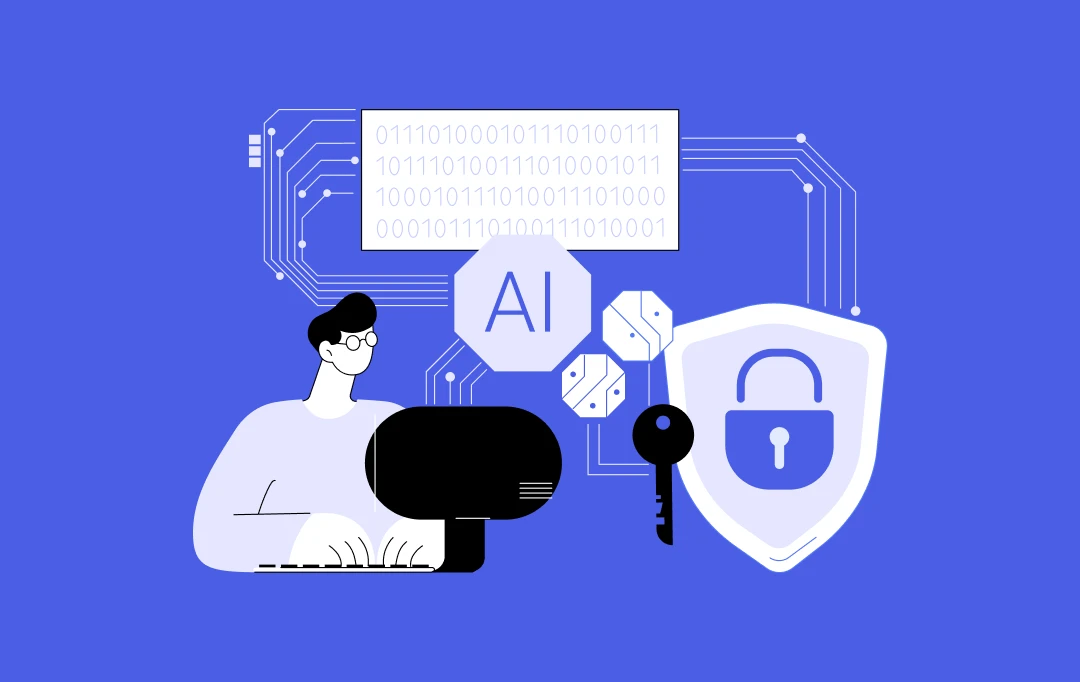
AI TRiSM - The Framework to Managing Risk, Building Trust, and Securing AI Systems
Artificial intelligence has taken over the modern business landscape by storm with its unparalleled efficiency in automation, analytics, personalization, fraud detection, medical diagnosis, and more, which was previously unimaginable. According to the Forbes Advisor survey, 64% of businesses believe that AI helps in increasing productivity and improving customer relationships, while a significant portion of organizations…





